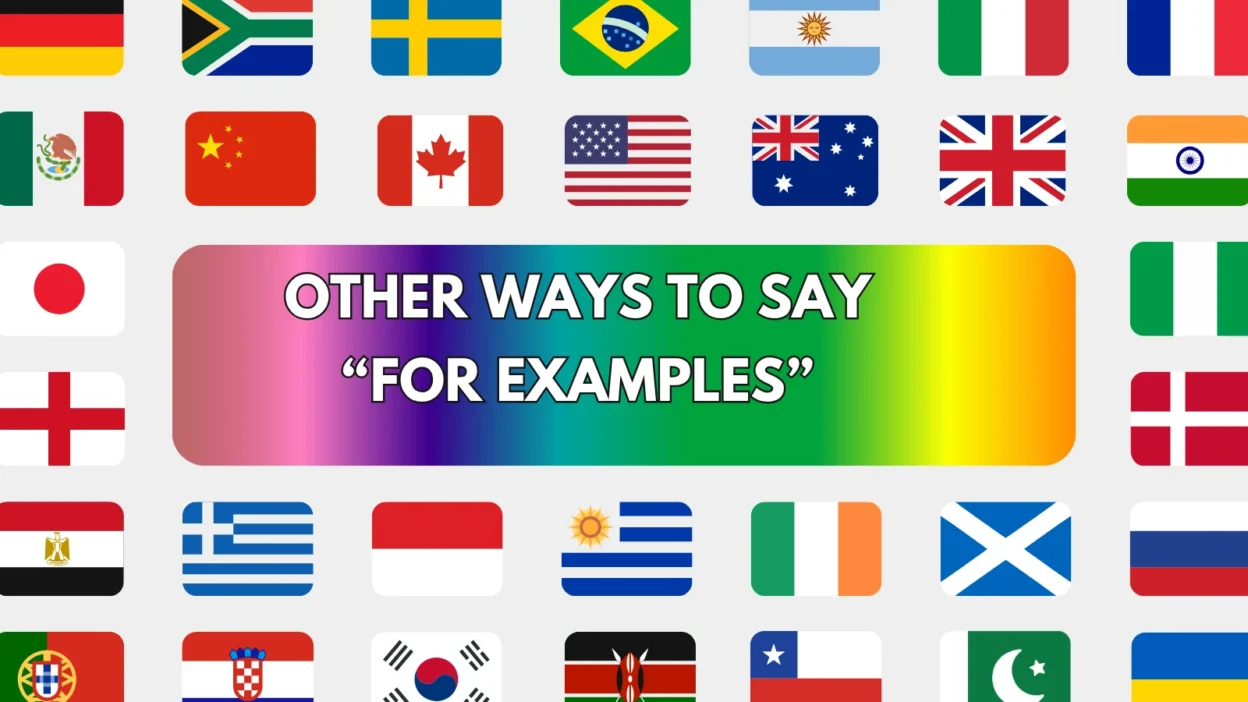The phrase “for example” is widely used in speech and writing to introduce a specific illustration or instance. It’s an essential part of clear communication, especially when trying to explain or support a point. However, using the same phrase repeatedly can become dull or repetitive.
This article presents 25 alternatives to “for example” that can help you sound more polished, precise, and engaging — whether you’re writing an essay, drafting an email, or giving a presentation.
1. Such as
Meaning:
Used to introduce specific instances or items as part of a general statement.
Detailed Explanation:
“Such as” is a casual and seamless way to integrate examples into a sentence without sounding overly formal.
Scenario Example:
You should eat more leafy greens, such as spinach and kale.
Best Use:
Essays, casual writing, business content.
Tone:
Neutral, informative.
2. For instance
Meaning:
Used to introduce a specific example or case.
Detailed Explanation:
“For instance” is very similar to “for example” but offers a slightly softer, more conversational tone.
Scenario Example:
Many apps offer useful tools. For instance, some track your water intake.
Best Use:
Presentations, articles, classroom explanations.
Tone:
Clear, polite.
3. To illustrate
Meaning:
Indicates that you’re providing an example to clarify a concept.
Detailed Explanation:
This phrase works well in formal writing when you need to demonstrate or explain something with evidence.
Scenario Example:
To illustrate, a high employee turnover rate may reflect poor management.
Best Use:
Academic writing, research papers.
Tone:
Formal, instructional.
4. Namely
Meaning:
Used to specify something previously mentioned.
Detailed Explanation:
“Namely” refines a broad idea by narrowing it down to specific examples.
Scenario Example:
Two countries were especially affected, namely, Italy and Spain.
Best Use:
Formal documents, academic writing.
Tone:
Precise, refined.
5. Let’s say
Meaning:
Introduces a hypothetical example to clarify an idea.
Detailed Explanation:
It’s often used in informal or conversational settings to help someone visualize a situation.
Scenario Example:
Let’s say you missed the deadline — what’s your backup plan?
Best Use:
Discussions, coaching, casual writing.
Tone:
Conversational, explanatory.
6. In particular
Meaning:
Draws attention to a specific example or detail.
Detailed Explanation:
“In particular” focuses on one case among many, highlighting it as especially relevant.
Scenario Example:
I enjoy outdoor sports — in particular, mountain biking.
Best Use:
Reports, essays, discussions.
Tone:
Emphatic, professional.
7. Case in point
Meaning:
Presents a real or relevant example of the point just made.
Detailed Explanation:
Used after a statement to show how a specific example proves the point.
Scenario Example:
She always follows through. Case in point: she stayed late to finish the client project.
Best Use:
Debates, essays, speeches.
Tone:
Persuasive, direct.
8. As an illustration
Meaning:
Presents an example that supports or explains an idea.
Detailed Explanation:
It sounds formal and is great for clear, academic-style writing.
Scenario Example:
As an illustration, we can consider the effects of pollution on marine life.
Best Use:
Essays, professional reports.
Tone:
Formal, descriptive.
9. Say
Meaning:
Offers a casual, often hypothetical example.
Detailed Explanation:
Short and conversational, this word is typically used in informal speech.
Scenario Example:
You might want to visit a museum — say, the Natural History Museum.
Best Use:
Conversations, informal writing.
Tone:
Casual, easygoing.
10. Including
Meaning:
Adds a few examples to support a larger category.
Detailed Explanation:
“Including” fits mid-sentence and flows naturally, providing a quick way to list examples.
Scenario Example:
He plays several instruments, including the piano and guitar.
Best Use:
Everyday writing, resumes, bios.
Tone:
Neutral, clear.
11. Specifically
Meaning:
Points to one particular example from a general group.
Detailed Explanation:
This word sharpens your focus and can add emphasis to your point.
Scenario Example:
The issue is with the software — specifically, the login module.
Best Use:
Technical writing, analysis, business memos.
Tone:
Focused, direct.
12. An example would be
Meaning:
Introduces a single, clear example.
Detailed Explanation:
This phrase is great for transitioning smoothly into an example without sounding abrupt.
Scenario Example:
An example would be using email marketing to retain customers.
Best Use:
Presentations, reports, training.
Tone:
Informative, smooth.
13. As proof
Meaning:
Provides evidence to support the claim.
Detailed Explanation:
This phrase signals that you’re presenting something factual to back up your statement.
Scenario Example:
As proof, the team increased sales by 30% after the campaign.
Best Use:
Persuasive writing, business cases.
Tone:
Assertive, confident.
14. As evidence
Meaning:
Highlights an example that supports a claim logically.
Detailed Explanation:
Often used in argumentative writing or academic work to show factual backing.
Scenario Example:
As evidence, look at the consistent rise in monthly users.
Best Use:
Essays, debates, research.
Tone:
Logical, strong.
15. In support of this
Meaning:
Introduces evidence or examples that strengthen an argument.
Detailed Explanation:
Useful in formal writing where you’re building a layered, reasoned case.
Scenario Example:
In support of this, several studies show improved learning with smaller class sizes.
Best Use:
Academic writing, formal letters.
Tone:
Professional, persuasive.
16. To give you an idea
Meaning:
Helps explain or visualize something through an example.
Detailed Explanation:
Informal and friendly — perfect for explaining concepts to non-experts.
Scenario Example:
To give you an idea, the waitlist grew to 5,000 people overnight.
Best Use:
Emails, conversations, training.
Tone:
Conversational, helpful.
17. Just to illustrate
Meaning:
Prepares the reader or listener for an example that supports the point.
Detailed Explanation:
Adds a touch of emphasis and works well in both speech and writing.
Scenario Example:
Just to illustrate, our last ad campaign doubled web traffic.
Best Use:
Presentations, persuasive talks.
Tone:
Clear, slightly emphatic.
18. Let me demonstrate
Meaning:
Prepares to show an example, often through action or explanation.
Detailed Explanation:
More common in spoken or instructional contexts where you’re actively walking someone through something.
Scenario Example:
Let me demonstrate how this formula works in practice.
Best Use:
Workshops, live demos, teaching.
Tone:
Practical, engaging.
19. Consider the case of
Meaning:
Introduces a real or hypothetical example for analysis.
Detailed Explanation:
Great for storytelling, analysis, or deep dives into a particular example.
Scenario Example:
Consider the case of Airbnb, which disrupted the hospitality industry entirely.
Best Use:
Case studies, analysis, reports.
Tone:
Analytical, reflective.
20. In other words
Meaning:
Rephrases or simplifies a point, often with an example.
Detailed Explanation:
Used for clarity, especially when the original point might be complex.
Scenario Example:
In other words, offering free shipping helps drive more online orders.
Best Use:
Explanatory writing, instruction.
Tone:
Clear, simplified.
21. Take the example of
Meaning:
Brings attention to a specific case or instance.
Detailed Explanation:
Direct and easy to understand, this phrase is great for storytelling or explanations.
Scenario Example:
Take the example of Tesla, which combined innovation with strong branding.
Best Use:
Speeches, essays, blogs.
Tone:
Direct, illustrative.
22. Among them
Meaning:
Selects one or more examples from a group.
Detailed Explanation:
Good for narrowing focus while showing the full range of options.
Scenario Example:
She’s worked on many successful brands — among them, Nike and Apple.
Best Use:
Resumes, bios, overviews.
Tone:
Professional, neutral.
23. A classic example is
Meaning:
Refers to a well-known or textbook example.
Detailed Explanation:
Useful for highlighting famous or universally accepted examples to support your point.
Scenario Example:
A classic example is Kodak, which failed to adapt to digital photography.
Best Use:
Presentations, lectures, case studies.
Tone:
Educational, authoritative.
24. Illustrated by
Meaning:
Used when the example visually or conceptually supports the idea.
Detailed Explanation:
This is often used when pointing to charts, images, or real-life cases.
Scenario Example:
This concept is illustrated by the chart on page 3.
Best Use:
Academic papers, reports.
Tone:
Formal, visual.
25. Evidence of this is
Meaning:
Introduces proof in the form of a specific example.
Detailed Explanation:
This phrase adds logical and persuasive weight to your argument.
Scenario Example:
Evidence of this is the 15% increase in employee satisfaction.
Best Use:
Persuasive writing, business analysis.
Tone:
Assertive, formal.
Conclusion
Instead of relying solely on “for example,” you now have a powerful toolkit of 25 different ways to introduce examples — each suited for different contexts, tones, and writing styles. Choosing the right phrase adds variety, professionalism, and clarity to your communication.




